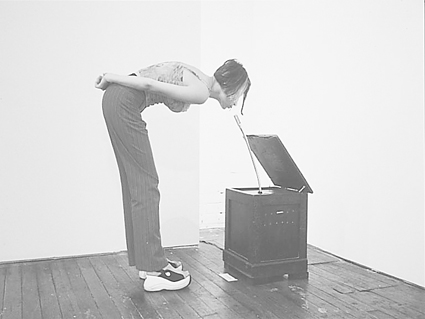Works in progress: interactive Installations

Mari Velonaki, Amor Veneris A
Amor Veneris A
Mari Velonaki
Amor Veneris A is a breath-activated installation (hard disk, breath sensor, various electronic media). A woman’s face is viewed through a magnifying glass which is installed on the top of a wooden box. The spectator can activate/awake her by blowing against her face using the breath switch which protrudes from the box and connects the spectator with the screen woman.
To use the breath switch to activate the quick-time movies, adaptations had to be made due to the fact that the switch was initially designed as an assisting device for people with paraplegia. These adaptations were implemented by means of a differential communications interface (RS-422) in a fully custom made electronics box. Breath sensor (switch) supplied by Enabling Devices-Toys for Special Children, NY, USA.
Mari Velonaki lives and works in Sydney. In a series of installations she aims to engage the spectator with the digital character in an interplay activated by sensory triggered interfaces (speech recognition, eye-tracking, breathing/blowing). Her work has been shown at Artspace, PICA and Ton-Bild Spectakel/Greifensee. Amor Veneris A is a derivative of Amor Veneris, Herringbone Gallery, Sydney, Mardi Gras, 1999.
MAAP 99, Science Centre, Brisbane, September 3 – 12.
A very Pentatonic Scale
Damian Castaldi
Video, installation and tuned aluminium bars. “The video plays the instrument” as light intensity levels vary depending on the changing video image of Curl Curl rockface and the spectator’s body movement between the screen and five transducers (mounted on a pentatonic scale).
The challenge is to program a MAX patch that will successfully coordinate the triggering process. This involves translating source data from Low Level 2 transducers to an analog to MIDI digitiser and outputting to actuators which play the pentatonic scale, to create an intriguing synergy between video, body and acoustics.
Damian Castaldi’s work explores audiovisual and instrumental crossroads between gesture-based, interactive audio systems and digital image for installation and the web. He was the 1997 recipient of the Australia Council New Media Art & Technology partnership with the ABC and works independently and in collaboration with the national artists’ collective nervous_objects.
Completion August 1999.
self remembering—optimal viewing distance
James Verdon
This is the 4th in a series of digital screen based installations interrogating memory and the electronic viewing screen as utilising common technologies of re-presentation and simulation. The installation seeks to articulate connections between memory and the electronic screen as viewed through the sieve of these technologies.
The primary technical challenges relate to the use of relatively unproven digital video delivery technology. The project utilises broadcast quality random access digital video and audio data from dedicated “black boxes.” This data is mixed with live video feed signal and lighting controls all triggered by a visitor’s jumping through a hopscotch court. No one in Australia has used this particular hardware before, and so the project has been a series of steep independent learning curves.
James Verdon is an artist working primarily with electronic media and emerging technologies, often utilising light as a primary interactive element. He is Course Coordinator and teaches theory and studio components of Electronic Design and Interactive Media (EDIM) in the Arts Department at Swinburne University of Technology in Melbourne.
Centre for Contemporary Photography (CCP), Melbourne, August-September 1999. Australia Council.
Facemen
David Cox
Utilising small ‘panasonic’ video LCD projector, commercial doll, video camcorder and face peep hole, Faceman is an installation which uses a small video projector to project the face of the onlooker onto a small puppet. By placing his/her face in a peep-hole cut in a flat surface the viewer then sees a puppet figure with a video-projected face. The work examines the complicity of the viewer in the form and nature of spectacular society.
In playing along with the implicit request of the work (to poke one’s head through the hole) the viewer automatically finds her face and speech transposed onto the symbol of manipulation—the puppet. The work aims to playfully examine the complex relationships between viewer and work, and by extension the role of video imagery in society as a whole.
The work extends ideas explored in earlier work, such as my 1990 black and white film Puppenhead. This and my 1998 film Otherzone examined the overall themes of identity, paranoia and technophobia. David Cox is Digital Screen Production Lecturer, Griffith University, Brisbane.
RealTime issue #32 Aug-Sept 1999 pg. 18






